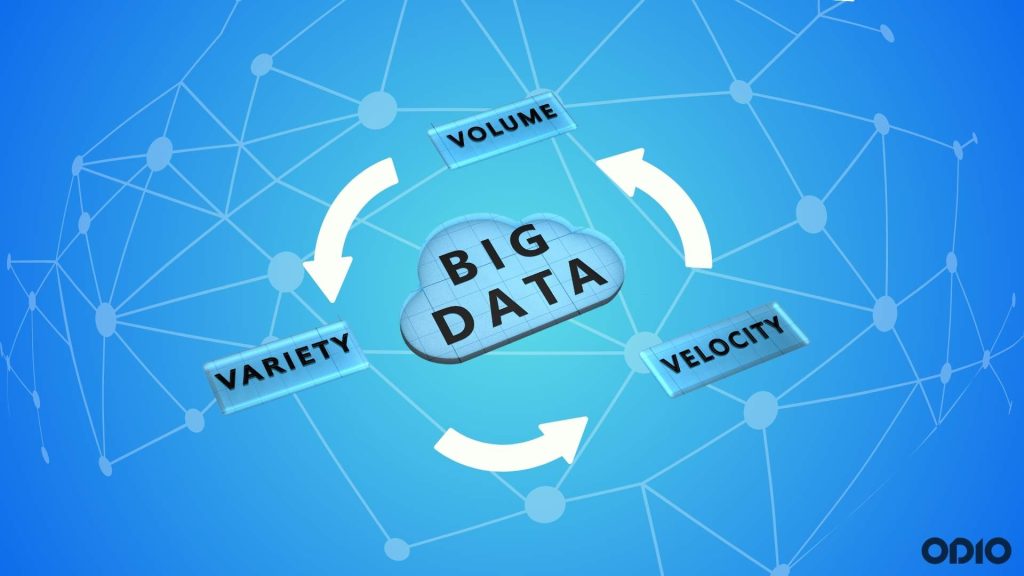
Contact centers stand at the frontline of customer interaction. Every call, every query, and every interaction holds valuable insights waiting to be harnessed. Enter big data – the game-changer revolutionizing how contact centers operate. According to a recent study, the global big data market is projected to reach $103 billion by 2027, with significant contributions from the contact center sector.
What is Big Data?
Big data refers to the vast volume of structured and unstructured data generated at an unprecedented velocity and variety. It encompasses everything from customer interactions, social media posts, to sensor data from IoT devices. The sheer magnitude of big data requires advanced analytics tools and techniques for processing and extracting meaningful insights.
Characteristics of Big Data

The three V’s – Volume, Velocity, and Variety – characterize big data. Volume denotes the sheer scale of data generated, while velocity refers to the speed at which data is produced and must be analyzed. Variety encompasses the diverse sources and formats of data, including text, images, videos, and more.
Types of Big Data
Big data can be categorized into structured, semi-structured, and unstructured data. Structured data is highly organized and fits neatly into databases, while semi-structured data lacks a formal structure but contains tags or metadata. Unstructured data, on the other hand, comprises text documents, social media posts, and multimedia content.
How can Big Data Improve Contact Center Performance?
As the heartbeat of customer engagement, contact centers are constantly seeking ways to enhance their performance. Enter big data – the catalyst for driving operational excellence and delivering exceptional customer experiences.
Role of Big Data in Contact Centers
Big data serves as a goldmine of actionable insights for contact centers. By analyzing customer interactions, sentiment analysis, and historical data, contact centers can optimize operations, enhance customer experiences, and drive business growth.
3 Keys of Big Data to Boost Call Center Efficiency
- Data Collection: Leveraging omnichannel communication channels to capture customer interactions across phone calls, emails, chats, and social media platforms.
- Data Analysis: Utilizing advanced analytics tools to process and analyze vast amounts of data in real-time, uncovering trends, patterns, and anomalies.
- Actionable Insights: Translating data-driven insights into actionable strategies, such as personalized marketing campaigns, targeted upselling, and proactive issue resolution.
5 Ways Big Data is Impacting the Call Center
In the fast-paced world of customer service, staying ahead of the curve is imperative. Big data, coupled with predictive analytics and AI, is reshaping the call center landscape, enabling organizations to deliver seamless and personalized customer experiences.
A. Predictive Analytics for Customer Behavior Forecasting
According to Forrester, companies that leverage predictive analytics experience a 73% increase in customer engagement rates. By analyzing historical data and customer demographics, contact centers can anticipate customer needs and preferences, enabling proactive customer engagement and personalized recommendations.
B. Personalized Customer Experiences through Data Insights
A study found that 91% of consumers are more likely to shop with brands that provide relevant offers and recommendations. By harnessing big data analytics, contact centers can create hyper-personalized customer experiences, tailored to individual preferences, purchase history, and browsing behavior.
C. Improved Agent Performance with Data-Driven Coaching
Research by McKinsey suggests that data-driven coaching can improve agent performance by up to 25%. By monitoring key performance metrics, such as first call resolution rates and average handling time, contact centers can identify areas for improvement and provide targeted coaching and training to agents.
D. Enhanced Operational Efficiency with Real-Time Data Monitoring
Real-time data monitoring enables contact centers to proactively identify and address operational issues, such as network congestion, system downtime, and staffing shortages. By leveraging big data analytics, contact centers can optimize resource allocation, streamline workflows, and ensure seamless customer experiences.
E. Proactive Issue Resolution and Customer Retention Strategies
According to Harvard Business Review, acquiring a new customer is 5 to 25 times more expensive than retaining an existing one. By analyzing customer feedback and sentiment data, contact centers can identify potential issues before they escalate, leading to faster resolution and higher customer satisfaction levels.
Companies Utilizing Big Data in Contact Centers
While the concept of big data in contact centers isn’t new, its application continues to evolve, driven by innovative organizations harnessing its power to gain a competitive edge. Let’s explore how industry leaders are leveraging big data to transform their contact center operations.
A. Successful Big Data Integration: Amazon
One notable example of successful big data integration in contact centers is Amazon. With its vast array of products and services, Amazon relies heavily on big data analytics to deliver exceptional customer experiences. By analyzing customer browsing behavior, purchase history, and feedback data, Amazon can personalize product recommendations, anticipate customer needs, and optimize supply chain operations.
B. Big Data Implementation: Salesforce
Salesforce, a leading provider of customer relationship management (CRM) solutions, is another prime example of big data implementation in contact centers. Salesforce’s AI-powered Einstein Analytics platform enables contact centers to harness the power of big data for predictive analytics, sentiment analysis, and personalized customer interactions. By leveraging AI and machine learning algorithms, Salesforce empowers contact centers to drive customer engagement and loyalty.
C. Big Data in Action: Telefonica
Telefonica, one of the world’s largest telecommunications companies, implemented a big data analytics solution to improve its contact center operations. By analyzing customer call logs, network performance data, and service inquiries, Telefonica was able to identify areas for improvement and enhance the overall customer experience. The implementation of big data analytics resulted in a significant reduction in call wait times, increased first call resolution rates, and higher customer satisfaction scores.
Challenges and Considerations
While the promise of big data in contact centers is undeniable, its implementation comes with its own set of challenges and considerations. Let’s explore some of the key obstacles organizations may encounter on their big data journey.
Data Security and Compliance
With the increasing volume and complexity of data, ensuring data security and compliance becomes paramount for contact centers. GDPR, CCPA, and other data privacy regulations impose strict guidelines on how organizations collect, store, and process customer data. Contact centers must implement robust security measures, such as encryption, access controls, and regular audits, to safeguard sensitive information and maintain regulatory compliance.
Integration of Big Data Solutions with Existing Contact Center Systems
Integrating big data solutions with legacy contact center systems can pose significant challenges, including compatibility issues, data silos, and interoperability constraints. Contact centers must carefully evaluate their existing infrastructure and choose big data solutions that seamlessly integrate with their existing systems. API-based integration, data connectors, and middleware solutions can facilitate data exchange and interoperability between disparate systems.
Skills and Training for Utilizing Big Data Effectively
Effective utilization of big data requires specialized skills and expertise, including data analytics, machine learning, and data visualization. Contact centers must invest in training and upskilling their workforce to leverage big data effectively. Providing employees with access to training programs, certifications, and hands-on workshops can empower them to harness the full potential of big data analytics and drive business outcomes.
Best Practices for Implementing Big Data in Contact Centers
Navigating the complexities of big data implementation requires a strategic approach and adherence to best practices. Let’s explore some key strategies for successfully implementing big data initiatives in contact centers.
1. Establishing Clear Objectives and KPIs
Before embarking on a big data initiative, contact centers must define clear objectives and key performance indicators (KPIs) aligned with their business goals. Whether it’s improving customer satisfaction, reducing operational costs, or increasing revenue, setting measurable targets ensures accountability and drives continuous improvement.
2. Investing in the Right Tools and Technologies
Selecting the right tools and technologies is critical for the success of a big data initiative. Contact centers must evaluate vendors, assess their capabilities, and choose solutions that align with their specific requirements and budget constraints. Whether it’s cloud-based analytics platforms, AI-powered chatbots, or predictive analytics tools, investing in the right technologies lays the foundation for success.
3. Creating a Data-Driven Culture within the Contact Center
Building a data-driven culture is essential for driving organizational change and fostering innovation. Contact centers must promote data literacy, encourage collaboration, and empower employees to make data-driven decisions at every level of the organization. By fostering a culture of experimentation and continuous learning, contact centers can unlock the full potential of big data and drive sustainable business growth.
Future Trends in Big Data and Contact Centers
As technology continues to evolve at breakneck speed, the future of big data in contact centers holds immense promise. Let’s explore some emerging trends and innovations that are set to shape the future of contact center operations.
A. AI and Machine Learning Advancements
The convergence of big data and artificial intelligence (AI) is poised to revolutionize contact center operations. Advanced machine learning algorithms can analyze vast amounts of data in real-time, enabling predictive analytics, natural language processing (NLP), and sentiment analysis. By automating routine tasks, such as call routing and customer inquiries, AI-powered chatbots can enhance operational efficiency and deliver personalized customer experiences.
B. Integration of IoT Data for Enhanced Customer Insights
The proliferation of Internet of Things (IoT) devices presents new opportunities for contact centers to gather real-time customer data and insights. From smart appliances to wearable devices, IoT sensors generate a wealth of data that can be leveraged to understand customer behavior, preferences, and usage patterns. By integrating IoT data with existing big data analytics platforms, contact centers can gain deeper insights into customer needs and deliver proactive support and services.
C. Predictive Maintenance for Contact Center Infrastructure
Predictive maintenance utilizes big data analytics and machine learning algorithms to forecast equipment failures and prevent downtime. By analyzing historical data, sensor readings, and maintenance logs, contact centers can identify potential issues before they occur, schedule proactive maintenance, and optimize resource allocation. Predictive maintenance not only reduces operational costs but also enhances service reliability and customer satisfaction.
Where Do You Start?
Embarking on a big data journey can seem daunting, but with the right strategy and approach, contact centers can unlock a world of possibilities. Let’s explore some key steps to kickstart your big data initiatives and drive tangible results.
1. Assessing Current Data Capabilities and Infrastructure
Before embarking on a big data initiative, contact centers must conduct a comprehensive assessment of their current data capabilities and infrastructure. This includes evaluating data sources, data quality, data governance policies, and IT infrastructure readiness. By understanding their existing strengths and weaknesses, contact centers can develop a roadmap for implementing big data solutions effectively.
2. Identifying Key Use Cases for Big Data in Contact Centers
Identifying key use cases is essential for prioritizing big data initiatives and maximizing return on investment (ROI). Contact centers should collaborate with cross-functional teams to identify areas where big data analytics can drive the most significant impact, such as customer engagement, operational efficiency, and revenue generation. Whether it’s predicting customer churn, optimizing workforce management, or personalizing marketing campaigns, focusing on specific use cases ensures targeted outcomes and measurable results.
3. Selecting the Right Big Data Solutions and Partnerships
Choosing the right big data solutions and partnerships is critical for the success of a contact center’s digital transformation journey. Contact centers should evaluate vendors based on their industry expertise, technology capabilities, scalability, and support services. Whether it’s cloud-based analytics platforms, on-premises solutions, or hybrid deployments, selecting the right partners ensures a seamless implementation and ongoing support for long-term success.
4. Implementing Pilot Projects for Proof of Concept
Implementing pilot projects allows contact centers to test and validate big data initiatives on a smaller scale before scaling up. By starting with proof of concept projects, contact centers can mitigate risks, validate assumptions, and demonstrate tangible results to key stakeholders. Whether it’s analyzing customer feedback data, optimizing call routing algorithms, or implementing predictive analytics models, pilot projects provide valuable insights and lessons learned for broader implementation.
That completes the guide to leveraging big data in contact centers. By harnessing the power of big data analytics, contact centers can unlock actionable insights, enhance customer experiences, and drive business growth in today’s data-driven world.
Thank you for reading. We hope this blog has been helpful in providing you with valuable information. Share your thoughts in the comments to have a conversation on why redaction is important for your contact center. For more insightful blogs like this, please follow our blogs at Odio.

